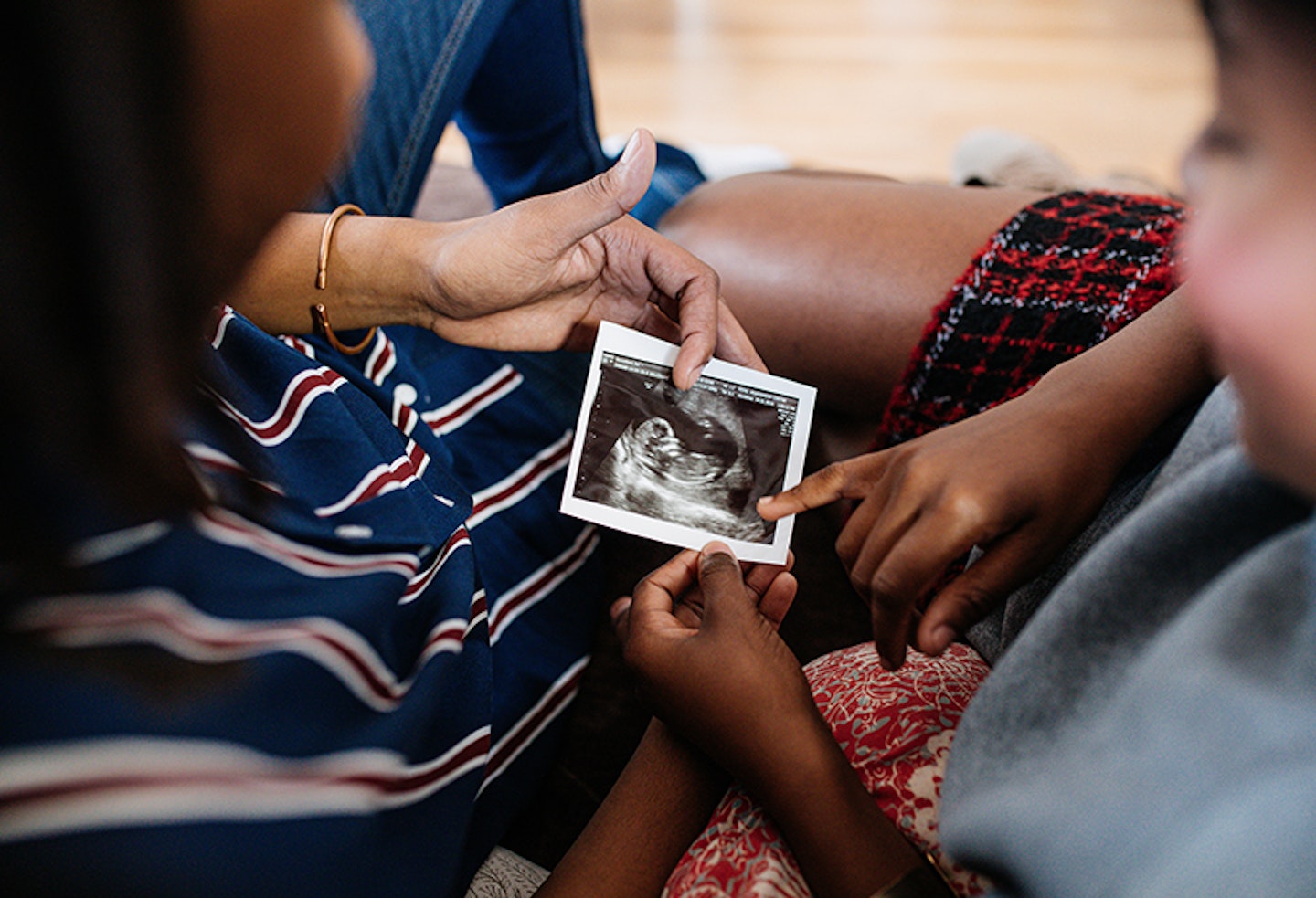Towards the end of your first trimester, as soon as you reach 12 weeks pregnant, you'll be invited for your 12-week scan. This is probably the first time you'll be able to clap your eyes on your baby as well as being the first of many pregnancy scans. It’s also the most exciting pregnancy milestone yet!
This milestone scan will show you a 2D image of your baby using high-frequency sound waves from a probe over your tummy, allowing you to get the first glimpse of your baby. It's sometimes called a dating scan, as this scan will be able to tell you the gestational age and when their due date will be.
So what exactly can you expect from your 12-week ultrasound?
When will I be offered my first pregnancy scan?
The NHS offers all pregnant women an ultrasound scan between 10 weeks pregnant and 14 weeks pregnant which usually ends up taking place at 12 weeks.
You will get a hospital appointment with a sonographer for your scan by letter. In the letter, there will be instructions on where to go and what is required.
The 2D image from the scan allows the sonographer to see your baby and work out baby's gestational age and when they're due, so you'll be given an idea of baby's due date which is why it is often called a dating scan!
You can see all their organs, muscles, limbs and bones are in place, and the sex organs are well developed too.
Do I have to have a scan?
When you first find out you are pregnant, your midwife or GP will provide you with information about all the screening tests offered during pregnancy and what they are for which should help you decide whether you want the scan or not.
The majority of women are excited to have their scan but if you are concerned, do speak with your GP or midwife as they may be able to offer alternative options such as a handheld doppler.
What does the 12-week scan reveal?
The 12-week scan is the first in-depth look at your growing baby and assesses the early development in the womb. Here's what else you should learn:
• Due date - Although you may already have a pretty good idea of roughly when you'll be meeting your baby, at your 12 weeks pregnant ultrasound you'll officially be given a due date. Eek! "The Crown Rump Length (CRL) is measured to check the date of the pregnancy and make sure it is in the 45 to 84mm range," explains Dean Meredith, a Sonographer at The Portland Hospital, London. Can't wait? Try our pregnancy due date calculator.
• How many babies you're having - Yep, you'll be finding out just how many babies are growing away in there.
• The heartbeat - Understandably one of the most nerve-wracking parts for any parents-to-be.
• Detect any anomalies - Your sonographer will make sure everything will be developing as it should. 'This includes the skull, the brain, the umbilical cord, the limb, the heart, stomach, bowel, pelvis, and bladder,’ says Dean.
• Your baby's NT or nuchal translucency - Also called a combined test, this is a specialised routine ultrasound performed at the end of the first trimester of pregnancy. The nuchal translucency measures the fluid at the back of the baby’s neck, combined with a blood test, and gives you an indication of the possibility of Down’s syndrome.
"Current guidelines for the 12-week scan is that it is undertaken alongside the Nuchal scan or Down’s screening," says Dean. You will not be offered the combined screening test if your dating scan happens after 14 weeks. Instead, you'll be offered another blood test between 14 and 20 weeks of pregnancy to screen for your chance of having a baby with Down's syndrome. This test is not quite as accurate as the combined test.
• Show the placenta positioning - The 12-week scan will also check the location of your placenta to ensure placenta praevia is not a concern.
Watch Mother&Baby editor Maria Martin attend her 12-week scan below:
Who can go with me?
You'll need to decide who you want to take to your scan. In most cases, you'll want your partner with you but if this isn't the case, consider taking a friend or family member. The support is invaluable. It is not recommended children attend the scan but do speak to the hospital if you are unable to sort childcare.
Getting ready for your 12-week scan
First things first, keep those nerves in check. We know how exciting and terrifying the whole thing is that you'll finally find out an estimated date of delivery, but too much anxiety and you’ll be jumping off the bed as soon as the gel touches your belly (it’s very cold!).
In order to create a clear view of your baby, it’s worth having a full bladder and drinking a pint of water an hour before the scan. "This pushes the uterus into a better position so we can see the baby more easily," says Dean. But don’t overdo it – we all know how often you need to peethese days.
What happens during the 12-week scan?
• You'll first be invited into a private room and asked to lie down on the bed.
• The sonographer will then ask you to expose your little bump so it's a good idea to wear comfortable clothes that are easy to pull up.
• The sonographer will put some gel on your tummy and will move a hand-held transducer device over your skin. The gel makes sure there is good contact between your skin and the device. The sonographer will tuck tissue paper around you to protect your clothing from the gel.
• A black and white image of your baby will appear on the ultrasound screen, which the sonographer will position so they get a good view.
• You will feel some pressure, but it shouldn’t be painful.
• You might be offered an internal vaginal examination instead, if your womb is sitting very deep in your pelvis, or if you are overweight. This type of scan will allow the sonographer to get closer to your baby.

Will I find out the sex of my baby at 12 weeks?
The 12-week scan is usually just about determining whether your baby is healthy and growing as they should be. Although the sex organs are well developed, it's usually too soon to see them at 12 weeks and you'll probably have to wait until the anomaly scan.
Some people however believe in the nub theory, which suggests you can determine the gender of your baby from that first ultrasound photo by looking out for the angle of the genital nub on your baby. If it is angled away from the body it indicates you're having a boy and if it is horizontal to the spinal cord it indicates you're having a girl. Other mums try the Chinese Gender Predictorto predict the sex. Alternatively, what about trying out skull theory?
How long will the scan take?
12-week scans normally take between 15 and 30 minutes, but it might take longer if your baby is lying in an awkward position. If the sonographer is unable to see what they need to, a repeat scan may be booked for another day.

What happens if a problem is found at the 12-week scan?
The 12-week scan is the first opportunity for your baby to be examined for any abnormalities that could indicate a problem with his development. That is unless you have had an early scan at 8 weeks.
If a problem is spotted you’ll be referred to a fetal medicine consultant for confirmation of the findings with a view to undergo further testing and recommendations for the remainder of the pregnancy.
There’s no evidence to suggest scans offer any risk to your pregnancy and offer you those first precious glimpses of your unborn baby and give you the peace of mind that your baby’s development is as it should be.
If there are no abnormalities spotted, you should get the results straight after the scan.
Some scans may not be successful, and the sonographer may not be able to gather enough information if your baby is lying in an awkward position, if you're overweight, or if you haven't been able to drink enough water to give yourself a full bladder. In this case, try not to worry. Your scan may be rebooked to gather more information on a different day.
When will the next scan be?
After your 12-week scan, your next ultrasound probably won't be until you're 20 weeks pregnant when you have your anomaly scan. This can also be a chance to find out if you're having a boy or girl if you choose to know.
You may also like to start thinking about if you might like a 4D scan in the future.
